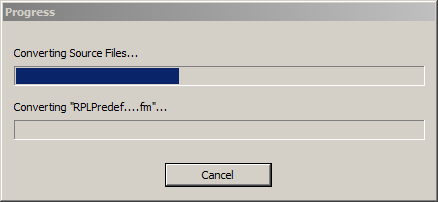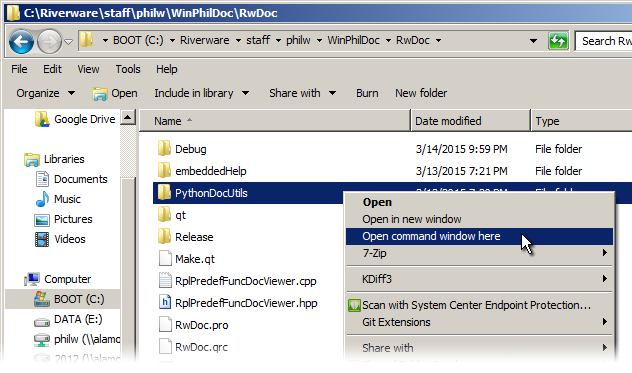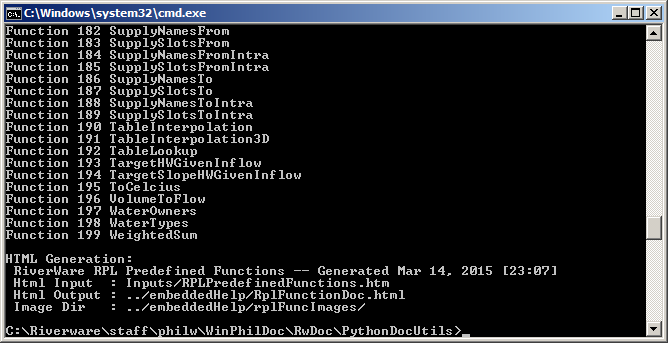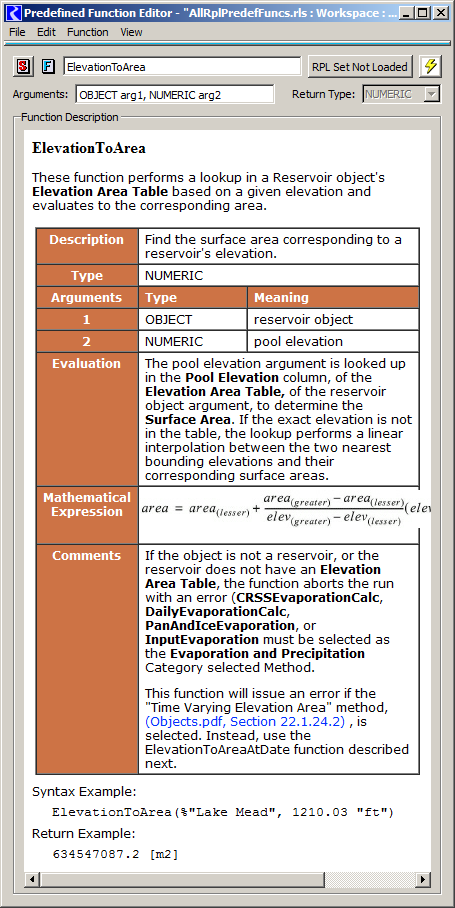Processing RPL Predefined Function Help for use in the RiverWare Build
Phil Weinstein, CADSWES, March 2015.
This document describes the process of exporting HTML from a FrameMaker 12 RiverWare
Online Help document
and procecessing that content for integration into the RiverWare build.
- Document Home: R:\doc\onlineHelp\process\GenRplFuncContent.html
- History:
- 3-17-2015: Revised overview; reference to feature document.
[PDF]
- 3-16-2015: Submitted for review. (Developed for RW 6.7).
Overview
RiverWare 6.7 displays RPL Predefined Function Online Help content, as HTML, in a QWebView panel.
The initial implementation displays this help content in three RPL dialogs. See this document:
- RPL Predefined Function Help content in RiverWare 6.7 /
March 2015
R:\doc\RPL\EmbedRplDoc\2015\RplFuncHelpInRiverWare-March2015.docx
R:\doc\RPL\EmbedRplDoc\2015\RplFuncHelpInRiverWare-March2015.pdf
[HTML]
[PDF]
The Function HTML help content (a single HTML file for all,
approximately 200 RPL Predefined Functions)
is bound to the RiverWare executable
as a Qt Resource.
(A compressed copy of the page -- without images
-- is part of the RiverWare executable).
Referenced images are loaded
dynamically by RiverWare's integrated QWebKit browser (Qt4 QWebView).
Major Process Steps:
(1) The RPL Predefined Function Online Help document is generated as
HTML from FrameMaker 12. This is display-only oriented HTML content,
lacking well-defined meta-data, e.g. for discerning which top-level
HTML elements correspond to particular functions.
(2) A Python 3 implemented processor translates the FrameMaker HTML
output into structured HTML, with semantic HTML/CSS classes and
other XML attributes to identify
functions (as new top-level HTML DIV elements) and the content
components which make up a function block.
The script also creates renamed copies of the exported images,
with names based on the function blocks in which they appear.
The script generates a directory containing:
- A single HTML file with all RPL Predefined Function help content.
- A subdirectory (folder) containing well-named images on that page.
(3) Automated:
At run time, RiverWare builds an internal XML DOM document (in memory)
from the bound HTML data and
creates a function-name index for top-level function DIV elements. On demand,
individual single function documents are built from those DIV elements and
displayed in a Qt4 QWebKit QWebView. As mentioned above, this QWebView is
deployed in three RPL Predefined Function-related dialogs.
Required Tools:
- FrameMaker 12 on Windows.
- Python 3. I'm using Python 3.4.0 (March 2014), 32-bit on my 64-bit Windows 7 system.
- A Windows RiverWare development area must be checked out from git (builds.git).
General Notes:
- The instructions below are for a RiverWare development area at "C:\Riverware\staff\philw\WinPhilDoc\". Adjust your process accordingly.
- The python script used in processing the HTML file is part of the RiverWare git repository (builds.git). Also checked in to that source repository are the direct input files and
output files for that python script. This does not include the original
FrameMaker source document for RPL Predefined Functions.
- The original FrameMaker source document lives in our central RiverWare/Doc area. It is under RCS source control, locally within its contained directory.
(1) If source document changes are needed ... check out RPLPredefinedFunctions.fm with RCS ... edit ... review ... and (perhaps later on) check in.
- On "alamosa" (a linux machine), in a command window, check out the source document (with a lock) using RCS.
- cd /projects/riverware/doc/onlineHelp/builds/RPLPredefinedFunctions/
- co -l RPLPredefinedFunctions.fm
- On Windows, START FrameMaker 12 and OPEN the document at the following analogous file path. (It's apparently normal to ignore the warnings about unavailable fonts and unresolved cross-references).
- R:\doc\onlineHelp\builds\RPLPredefinedFunctions\RPLPredefinedFunctions.fm
- Carefully and deliberately edit the document using the style and format conventions of the document. Most styles are important -- they are used by the python script to identify the content structure and semantic types. Also important are the row title words in the first column of each function's main table -- those are also used as keywords by the python script, e.g. Description, Type, Arguments, [Argument Numbers, starting at 1], Evaluation and optional Comments. Math formula bounding boxes should not have a lot of extra internal padding space, especially on the left side.
- Checking the edited documented back in (to RCS) can be done at any point in the following process. (It does not have to happen right now). But when you are pretty sure that your edits are complete and final, type in the following command in your "alamosa" (linux machine) command window to check your changes into RCS and unlock the file. (Refer to other RCS commands if, for some reason, the file you edited hadn't actually been locked).
- cd /projects/riverware/doc/onlineHelp/builds/RPLPredefinedFunctions/
- ci -u RPLPredefinedFunctions.fm
- ... type in a descriptive "change" message.
(2) Open RPLPredefinedFunctions.fm (again) in FrameMaker 12.
(3) File >> Publish ... shows this panel:

(4) Confirm "US_ASCII" character encoding ...
- See screenshots below.
- Note: The Publish Settings dialog forces you to save the configuration change to a special file in order to apply it. Go ahead and do that, in a reasonable user folder in which you have "write" permissions.
- Notice the Output directory setting. This was the default (for the "philw" user).

(5) Double-click "WebHelp" ... this takes a few minutes ...


... click Done.
(6) View these two folders:
- C:\Users\philw\FMOutput\RPLPredefinedFunctions-WebHelp\
- C:\Riverware\staff\philw\WinPhilDoc\RwDoc\PythonDocUtils\Inputs\
- Create or Delete Contents of Folder: [B] fmFuncImages.
- Copy [A] RPLPredefinedFunctions.htm to [B].
- Copy [A] RPLPredefinedFunctions*.jpg and .bmp to Folder: [B] fmFuncImages.
Note: In the course of making a sequence of text-only edits, sub-step #3 above -- copying images -- is not always necessary.
(7) Open a Windows command window in
C:\Riverware\staff\philw\WinPhilDoc\RwDoc\PythonDocUtils\
- See screenshot below ... This can be done from the context menu in the containing folder. (Your Windows configuration may require the <SHIFT> key to be held when right-clicking on a folder for the "Open command line window here" operation to appear in the context menu).

(8) Run the python script
- Type processRplPredefFuncs.py ... (or python processRplPredefFuncs.py )
- ... this is the expected result:

The output of the python script is used in two places:
- The RiverWare build. Only the generated HTML file
(and not the page's images) becomes part of the RiverWare build.
(See Step 9).
- The RiverWare runtime file distribution. A directory including the
generated HTML file and a subdirectory with the page's images is copied
to the RiverWare executable directory -- or to the directory pointed to by
the optional RiverWare Home environment variable. (See Step 10).
Note that both the "RwDoc/PythonDocUtils/Inputs/" directory and the generated the "RwDoc/embeddedHelp/" directory
are part of the RiverWare development area under git control. That is,
they both get checked in when committing changes in git.
(9) Build RiverWare in Visual Studio
- The change to file RwDoc/embeddedHelp/RplFunctionDoc.html -- as a
result of running the python script in the prior step -- will cause
a rebuild of the RwDoc library. This will be quick if the build area had
otherwise been up to date. In general, only these modules will be built (in addition to the RiverWare executable itself):
- RwDoc.qrc (with RCC, the Qt Resource compiler)
- qrc_RwDoc.cpp
- RwDocGenerated.lib
(10) Copy the generated directory to the RiverWare executable directory
-- and ultimately to the RiverWare release deployment area.
- Copy the "RwDoc/embeddedHelp" subdirectory (folder)
to the directory containing the RiverWare executable.
- The RiverWare program looks for the "embeddedHelp" directory
under the program directory AND IN the directory pointed to by the optional
RiverWare Home environment variable. If not found, the following message
(for example) is sent to RiverWare Diagnostics:
The Embedded RiverWare Help directory (embeddedHelp) was not found under the RiverWare executable directory (C:/Riverware/staff/philw/WinPhilDoc/EngrObjs/debug) nor under the application directory (C:\Program Files\CADSWES\RiverWare 6.6\) defined with the optional application environment variable (RIVERWARE_HOME_67).
- During development (including revisions to the RPL Predefined Functions
document), this step isn't always necessary.
The HTML file (itself) under the executable directory isn't actually used
by the running RiverWare program. Only the webpage's images under that
directory are used. Those will not typically change, and nothing terrible
happens if a new image is missing.
(11) Test, and with Git Extensions: commit and push changes.
- We use the "Git Extensions" Windows GUI application to manage local changes in git.
- Note: Of all of our developers, only one uses our update-id.sh utility to timestamp files before committing. (This is to be run in a Git Bash command line window at the top of the development tree; it effects only "staged" files, which must be re-staged after running this script). It is NOT IMPORTANT to run this utility. (Note that this had been an automatic feature of CVS. Git does not inherently support this timestamp provision). Not doing so will leave the original "$Id$" comment in the generated HTML file (which at least does include the file name). That will show up as a change to that file (as a difference indicated in Git Extensions). Not a problem. [This shell script file currently resides at C:\Riverware\bin\update-id.sh. It uses the set-id.pl perl script and git command line tools].
--- (end) ---







